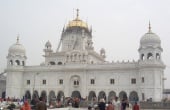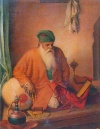Template:Did you know: Difference between revisions
From SikhiWiki
Jump to navigationJump to search
Hari singh (talk | contribs) No edit summary |
Hari singh (talk | contribs) No edit summary |
||
| Line 2: | Line 2: | ||
{{aowhy|[[Template:Did you know|Did you know...]]}}<div style="background-color:#FFFFEC;"> | {{aowhy|[[Template:Did you know|Did you know...]]}}<div style="background-color:#FFFFEC;"> | ||
*....the [[Guru Granth Sahib]] is the eleventh [[Sikh Guru]] and [[perpetual Guru of the Sikhs]] to guide the Sikhs and others to eternity. | |||
* .... | |||
* .... that [[ | *.....that the [[Sikh Beliefs|'''Sikhs believe''']] that all life, including human life, '''comes from God'''. God is the Creator of the universe and the force that keeps it in existence. | ||
[[Image:Dukh Nivaran 01.jpg|thumb|170px|right|{{cs|'''Gurdwara Dukh Nivaran Sahib Patiala'''}}]] | |||
*..... that [[Gurdwara Dukh Nivaran Sahib Patiala]] marks the place where [[Guru Tegh Bahadur]] visited village Lehal on 24 January 1672 and stayed under a banyan tree by the side of a pond. Soon the sickness in the village subsided. The site where the Guru had sat came to be known as ''"Dukh Nivaran"'' literally meaning ''Eradicator of suffering''. | |||
* ... that | *.....that one of the '''five forts''' in [[Anandpur Sahib]] built by [[Guru Gobind Singh]] was called '''[[Keshgarh Fort]]'''. | ||
*..... that the [[Sikh]] | [[Image:Mian Mir.jpg|100px|left|Hazrat Mian Mir]] | ||
*..... that '''Hazrat [[Mian Mir]]''' was a famous [[Muslim]] Sufi saint who is highly respected by the Sikhs. He was a close friend of the Sikh leader [[Guru Arjan Dev]], upon whose invitation he laid the foundation stone of the famous Sikh [[Golden Temple]] in [[Amritsar]] on 3 January 1588. | |||
* .... that [[Bhagat Kabir]] ([[Gurmukhi]]: ਭਗਤ ਕਬੀਰ) (1441-1518) was a saint born in [[Bharat]], present day India and Pakistan. 500 verses of Bhagat Ji’s [[Bani]] are included in the [[Guru Granth Sahib]]. | |||
*..... that the word [[Singh]] from [[Sanskrit]] '''sinha''' which means '''Lion''' and is an essential component of the name for a Sikh male. | |||
<!----------------------------------Disabled ----------------------- | <!----------------------------------Disabled ----------------------- | ||
* .... that [[Bhagat Kabir]] ([[Gurmukhi]]: ਭਗਤ ਕਬੀਰ) (1441-1518) was a saint born in [[Bharat]], present day India and Pakistan. 500 verses of Bhagat Ji’s [[Bani]] are included in the [[Guru Granth Sahib]]. | |||
*....the [[Guru Granth Sahib]] is the eleventh [[Sikh Guru]] and [[perpetual Guru of the Sikhs]] to guide the Sikhs and others to eternity. | |||
[[Image:Laava6-M3.jpg|150px|left]] | [[Image:Laava6-M3.jpg|150px|left]] | ||
*....that '''[[Anand Karaj]]''' is the name given to the [[Sikh]] wedding [[Sanskar|ceremony]], literally translated as "Blissful Occasion". Sikhs regard [[Anand karaj|marriage]] as a sacred bond of mutual dependence between a man and a woman. | *....that '''[[Anand Karaj]]''' is the name given to the [[Sikh]] wedding [[Sanskar|ceremony]], literally translated as "Blissful Occasion". Sikhs regard [[Anand karaj|marriage]] as a sacred bond of mutual dependence between a man and a woman. | ||
Revision as of 21:45, 30 January 2009
Did you know...
- ....the Guru Granth Sahib is the eleventh Sikh Guru and perpetual Guru of the Sikhs to guide the Sikhs and others to eternity.
- .....that the Sikhs believe that all life, including human life, comes from God. God is the Creator of the universe and the force that keeps it in existence.
- ..... that Gurdwara Dukh Nivaran Sahib Patiala marks the place where Guru Tegh Bahadur visited village Lehal on 24 January 1672 and stayed under a banyan tree by the side of a pond. Soon the sickness in the village subsided. The site where the Guru had sat came to be known as "Dukh Nivaran" literally meaning Eradicator of suffering.
- .....that one of the five forts in Anandpur Sahib built by Guru Gobind Singh was called Keshgarh Fort.
- ..... that Hazrat Mian Mir was a famous Muslim Sufi saint who is highly respected by the Sikhs. He was a close friend of the Sikh leader Guru Arjan Dev, upon whose invitation he laid the foundation stone of the famous Sikh Golden Temple in Amritsar on 3 January 1588.
- .... that Bhagat Kabir (Gurmukhi: ਭਗਤ ਕਬੀਰ) (1441-1518) was a saint born in Bharat, present day India and Pakistan. 500 verses of Bhagat Ji’s Bani are included in the Guru Granth Sahib.


